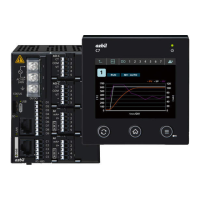ix
4 - 10 DO (Digital Output) 4-65
DI/DO configuration 4-65
DO assignment 4-66
4 - 11 TP (Time Proportioning) Output 4-68
DI/DO configuration 4-69
TP output type 4-69
TP cycle 4-70
TP operation type 4-70
Linearization table group definition 4-71
4 - 12 Analog Output (AO) 4-72
Output range 4-72
Output type 4-72
Loop definition 4-73
Output scaling low and high limits 4-73
Linearization table group definition 4-74
4 - 13 Motor Drive Output (Position Proportional Control) 4-75
Output type 4-75
Control method 4-76
MFB AT (MFB auto-tuning) 4-77
MFB adjustment value 4-78
Dead zone 4-79
Linearization table group definition 4-80
4 - 14 CT (Current Transformer) Input 4-81
Number of turns and number of power wire loops 4-81
CT input display range and current measurement range 4-82
Current measurement and error detection 4-83
Condition for restoring status before measurement 4-88
Timing for updating CT current measurement 4-88
4 - 15 VT (Voltage Transformer) Input 4-89
Primary voltage and secondary voltage 4-89
4 - 16 Linear Approximation 4-90
Linearization by specifying breakpoints 4-90
Linearization by specifying bias 4-91
Example using linear approximation by analog input 4-91
Example using linear approximation for analog output 4-92
When the increase in magnitude of the breakpoints on the A-axis is not in
numerical order 4-94
When two adjacent breakpoints have the same value on the A-axis 4-94
4 - 17 Internal Cascade 4-95
Master/Slave 4-95
Loop Types 4-95
Example: Internal cascade settings 4-96
4 - 18 Logical Operations 4-98
Processing order for logical operations 4-98
Calculation type 4-99
Input assignments A, B, C, and D 4-99
Input bit polarities A, B, C, and D 4-99
Reverse 4-100

